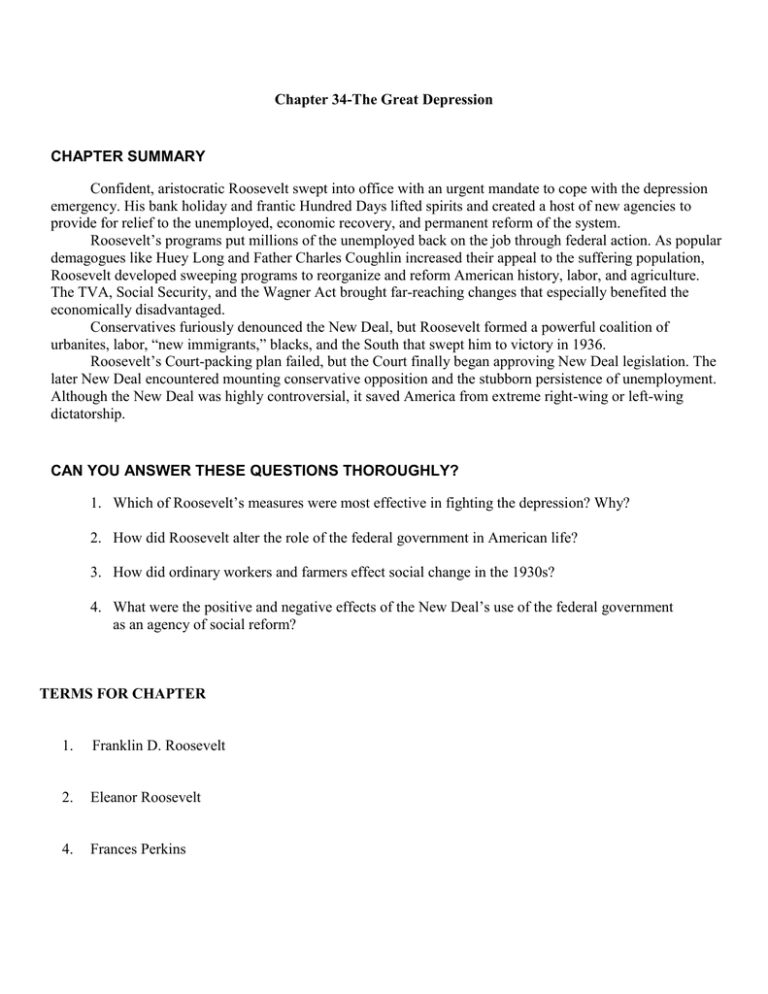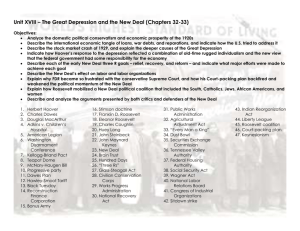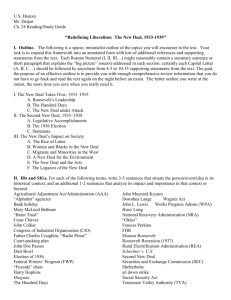Terms and homework for Chapter 34
advertisement

Chapter 34-The Great Depression CHAPTER SUMMARY Confident, aristocratic Roosevelt swept into office with an urgent mandate to cope with the depression emergency. His bank holiday and frantic Hundred Days lifted spirits and created a host of new agencies to provide for relief to the unemployed, economic recovery, and permanent reform of the system. Roosevelt’s programs put millions of the unemployed back on the job through federal action. As popular demagogues like Huey Long and Father Charles Coughlin increased their appeal to the suffering population, Roosevelt developed sweeping programs to reorganize and reform American history, labor, and agriculture. The TVA, Social Security, and the Wagner Act brought far-reaching changes that especially benefited the economically disadvantaged. Conservatives furiously denounced the New Deal, but Roosevelt formed a powerful coalition of urbanites, labor, “new immigrants,” blacks, and the South that swept him to victory in 1936. Roosevelt’s Court-packing plan failed, but the Court finally began approving New Deal legislation. The later New Deal encountered mounting conservative opposition and the stubborn persistence of unemployment. Although the New Deal was highly controversial, it saved America from extreme right-wing or left-wing dictatorship. CAN YOU ANSWER THESE QUESTIONS THOROUGHLY? 1. Which of Roosevelt’s measures were most effective in fighting the depression? Why? 2. How did Roosevelt alter the role of the federal government in American life? 3. How did ordinary workers and farmers effect social change in the 1930s? 4. What were the positive and negative effects of the New Deal’s use of the federal government as an agency of social reform? TERMS FOR CHAPTER 1. Franklin D. Roosevelt 2. Eleanor Roosevelt 4. Frances Perkins 5. Father Coughlin 6. Huey Long 7. Francis Townsend 10. John L. Lewis 12. boondoggling 14. New Deal 15. Brain Trust 16. Hundred Days 17. the “three Rs” 18. Glass-Steagall Act 19. Civilian Conservation Corps 20. Works Progress Administration 21. National Recovery Act 22. Schechter case 24. Agricultural Adjustment Act 25. Dust Bowl 26. Securities and Exchange Commission 27. Tennessee Valley Authority 28. Federal Housing Authority 29. Social Security Act 30. Wagner Act 31. National Labor Relations Board 32. Congress of Industrial Organizations 33. Liberty League 35. Twentieth and Twenty-first amendments 36. Court-packing scheme HW for this chapter: Read Zinn's chapter titled "Self-help in Hard Times". Answer the following questions in your notebook (to be graded when I check notebooks). Zinn: Self Help In Hard Times Chapter 15 http://www.historyisaweapon.com/defcon1/zinnselhel15.html 1. Why does Zinn (and J.K. Galbraith) say the stock market crashed in 1929? 2. How would a mainstream economist differ in explaining the Great Crash of 1929 from a socialist critic? 3. Why, when there was enough food, housing, clothing, and work for all did so many go without these necessities in the early years of the Depression? 4. What were factors influencing the election of 1932? What were Roosevelt's two main objectives with the New Deal, and what are examples of implementing each? 5. What kinds of self help did people organize apart from government aid? 6. Why did the Wagner-Connery Act pass, and what were some results? 7. How did the NRA try to stabilize the system? 8. What are examples of Roosevelt's efforts to balance the needs of workers with the demands of businesses? 9. What kinds of tensions were there between European-Americans and AfricanAmericans, rank and file unionists and union leadership during the Depression? 10. How did the government work to control direct labor actions in the 1930? 11. How did the New Deal affect capitalism? Affect African-Americans?




